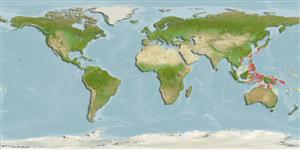Classification / Names
Common names from other countries
Main reference
Size / Weight / Age
Max length : 1.8 cm SL male/unsexed; (Ref. 93270); 1.5 cm SL (female)
Environment
Marine; reef-associated; depth range 3 - 18 m (Ref. 93270)
Climate / Range
Subtropical, preferred ?
Distribution
Western Pacific: Japan and the Phiippines.
Countries | FAO areas | Ecosystems | Occurrences | Introductions
Short description
Dorsal
spines
(total): 7;
Dorsal
soft rays
(total): 8-9;
Anal
spines: 1;
Anal
soft rays: 8;
Vertebrae: 26. This species is distinguished from its congeners by the following set of characters: cephalic sensory-pore system pattern group I (complete); dorsal/anal fin-ray formula 8/8; absence of the fifth pelvic-fin ray; 5 internal bands between anal-fin origin and caudal-fin base; pale colour of pectoral fin base and the spinous dorsal fin; presence of a dark rectangular caudal-peduncle spot above midline; no broad dark and light bands; posterior edge of opercular membrane with a concentration of dark chromatophores; in life red-orange spots along bases of both dorsal fins, and belly with distinct red spots (Ref. 93270).
IUCN Red List Status (Ref. 115185)
Threat to humans
Harmless
Human uses
More information
Common namesSynonymsMetabolismPredatorsEcotoxicologyReproductionMaturitySpawningFecundityEggsEgg development
Age/SizeGrowthLength-weightLength-lengthLength-frequenciesMorphometricsMorphologyLarvaeLarval dynamicsRecruitmentAbundance
ReferencesAquacultureAquaculture profileStrainsGeneticsAllele frequenciesHeritabilityDiseasesProcessingMass conversion
Tools
Special reports
Download XML
Internet sources
Estimates of some properties based on models
Phylogenetic diversity index
PD50 = 0.5000 many relatives (e.g. carps) 0.5 - 2.0 few relatives (e.g. lungfishes)
Trophic Level
3.0 ±0.3 se; Based on size and trophs of closest relatives
Resilience
High, minimum population doubling time less than 15 months (Preliminary K or Fecundity.)
Vulnerability
Low vulnerability (10 of 100)
Price category
